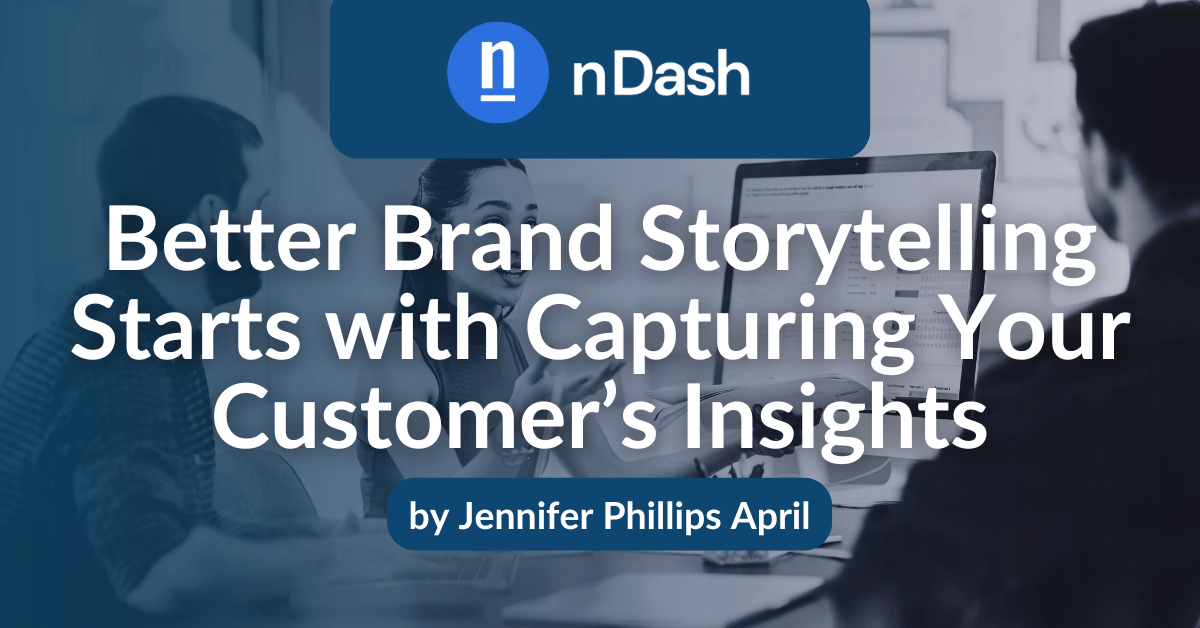Every brand has captivating stories. Yet, those powerful stories are often trapped in Slack threads, call transcripts, or forgotten decks. With the right system, brand storytelling becomes second nature, and your writers can craft unforgettable narratives.
Why Great Brand Storytelling Gets Lost Before It Reaches Your Audience
Some of the best brand narratives happen informally through DMs or sales calls. You don’t know how much a casual reference can resonate if you can’t use it in your content.
Build a stronger brand voice with an easy capture system.
Great Stories, Missed Opportunities
Bland content briefs do a disservice to your writers and your brand. That juicy quote from a customer? Gone, unless someone captured it. Your founder’s passionate rant in a Slack thread is buried forever unless someone saves it and puts it in a central location.
When your content team infuses briefs with real language, your writers can deliver emotional juggernauts your prospects remember.
One quote can anchor an entire piece. For example, I once interviewed a customer for a dog grooming software scheduling tool. The business owner mentioned they saved $80,000 per year per groomer thanks to the notification feature on the software. That insight became the core of that piece.
Shareable stories are memorable.
Data Backs It Up
Brand storytelling is more than vibes; it’s a business advantage.
Fifty-five percent of consumers are more likely to remember a brand that tells a compelling story. Entrepreneur reports that brand stories with an authentic, emotional core are more relatable and create stronger connections.
Brands that take a people-first, storytelling approach capture attention and trust.
A Simple System for Consistent Brand Storytelling and Voice
You don’t need a shiny new tool. You need a low-effort, high-impact system for capturing and reusing stories that exist across your team.
Record and Repurpose Internal Gold
First, don’t think of this as a capital “P” Project. This can be scrappy and fit into what you’re already doing. You can start by asking teams to submit one memorable customer quote, story, or product analogy a quarter.
Hold short roundtables or async voice memos. Ask your sales or customer success teams: “What’s something a customer said this month that really stuck with you?” Record and transcribe using AI tools and store quotes in a shared doc. Google Docs or Notion works great.
In a Slack channel, a peer described a recent project by their Voice of Customer team. They created a spreadsheet to track and highlight customer quotes, sentiment, location, and topic during a large-scale migration. He’d share specific quotes to include in decks and with the product team.
What to Look For
Storytelling gold lies in emotional, specific language. Ask your team to listen for “aha’s” like “This added $80k a year per team member, “ or “It’s a GPS for your onboarding.” Such phrases help your prospect quickly grasp your product’s purpose.
When you hear something surprising, ask follow-up questions if possible. If someone says they’re saving 12 hours a week, ask them to walk you through their before and after. Details create the story.
These quotes and insights become reusable story blocks. Repurpose them in blog posts, nurture emails, and decks. They bring emotion, context, and stickiness to your message.
How Writers Can Turn Raw Insights into Stronger Brand Storytelling
Imagine giving your writers a resource packed with real examples, vivid language, and context. Now, they’re working with insights from your customers instead of bland keyword terms.
Going Beyond the Brief
Real-world examples go deeper than “approachable yet authoritative.” It helps writers mirror tone and phrasing with specific insights related to your customer. Eric Doty is the Content Lead at Dock. He’s put together extensive onboarding documents for his slate of freelance writers. This onboarding includes the target audience and their specific challenges, plus links to some of the brand’s most successful content.
Such added details like context and specific language help your writers go beyond keyword goals or word length and turn a working draft into insider speak.
Writers Become Storytellers, Not Just Typists
Access to internal stories leads to stronger narratives because your writers can tap into emotion. They’re able to embody the brand voice and lend a ‘been there, here’s how we did it’ tone.
As Nick Richtsmeier at CultureCraft says, “The delivery matters. A gesture, a phrasing, the rhythm of how something is said — all of it shapes how it’s received.”
Writing well isn’t enough. When you provide your writers with real source material that shares how your team and customers talk, they can create work that resonates.
A Real Example of Brand Storytelling That Works
Stronger brand storytelling can be as simple as a deck of customer testimonials.
The Deck That Changed Everything
One client, an up-and-coming B2B tech brand, shared a quote-rich deck packed with customer quotes and internal phrasing. It wasn’t another static brand voice guide but a snapshot of how customers actually talked about the product.
It was gold.
Quotes like:
“[Brand] is an efficient and easy-to-use platform hitting the right balance of technical simplicity and flexible customization,” or “It handles reporting like a breeze.”
That deck helped me draft sharper intros that felt on brand. It provided insights into the value of the product, enabling more confident and persuasive messaging. It also made for fast approvals and excellent results.
Repeatable, Not One-Off
The magic lies in the repeatable framework. Imagine creating a habit of capturing language from internal teams and customers. You can capture stories quarterly, after a product launch, or big wins.
Create a simple system to surface ideas. That could involve chatting with a few customers, checking Slack, browsing Reddit, and communicating with sales and customer success teams. Compile your findings into a Google Sheet or Notion file and pair them with upcoming content themes or campaign goals.
Brand storytelling gets easier.
Takeaways to Strengthen Your Brand Storytelling Strategy
Brand storytellers don’t invent narratives from scratch. They build on material already there. You don’t need a big team or complex tools. You need a simple content creation strategy that makes storytelling easy and repeatable.
Actionable Next Steps
Here’s how to turn today’s insight into tomorrow’s brand storytelling.
Create a shared “Voice Vault” or “Story Sparks” doc
Start with a simple Google Doc, Notion board, or Slack thread. Label it clearly and make it easy to drop in quotes, analogies, or customer stories. Invite your team to add to it. Maybe implement a “Friday Roundup” and remind the team to save interesting customer quotes or insights from the week every Friday.
Assign ownership
Nothing happens without a deadline and ownership. Assign someone to collect, tag, and refresh your brand stories. Additionally, you can train AI to help surface stories within Slack threads and tag them. Need ideas? Someone from marketing ops, content leads, or even a rotating editor can run point.
Give writers access, not just assignments.
Provide your writers with context and access to ICP research. Give them the language they need to bring your brand voice to life and tell a compelling story.
Your Voice Is Already There — Just Capture It
Brand storytelling isn’t born in the boardroom; it comes from your customer calls, sales demos, and phrases your team uses without thinking.
You simply need to capture those ideas. When you build a simple, repeatable system for collecting customer quotes and team discussions, you give your writers raw material to add brand flavor to your content.
The best brand stories are relatable, consistent, and build trust.
Powerful brand storytelling starts with listening. Listen to what others say about your brand, capture those ideas and quotes, and share on purpose.
About the Author

Jennifer Phillips April is a seasoned B2B technology copywriter with a focus on hospitality tech, pet tech, and B2C pet industry. With a background in journalism and over a decade of experience, she blends SEO expertise with customer psychology. Check out her nDash profile to learn more about how she can level up your content strategy: Jennifer Phillips April.
